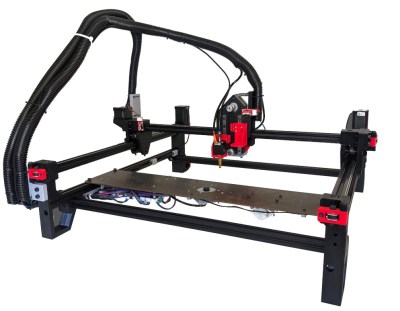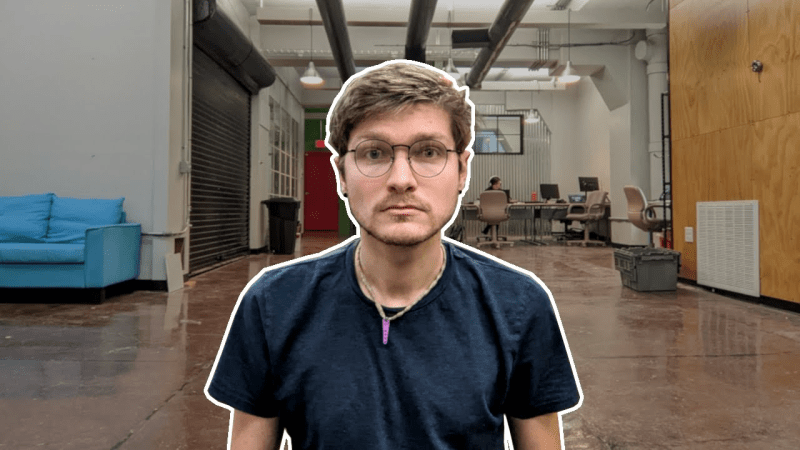We love it when an Open Source hardware project grows up and turns into a sustainable business, bootstrapped with nothing but hard work and great ideas, but it’s a really tough prospect to do it using your own money, ploughing the profits from any sales back into development and not taking a dime in wages whilst you do so. People obviously need an income to live off, and that time spent working on a startup is time you can’t spend earning your keep. So it’s with great pleasure that we can bring you the latest news from [Stephen Hawes] and his pick-and-place machine plans. In the year since we last checked in with the project, development has continued at a steady pace, with the guys quickly outgrowing the garage workspace, whilst they prepare PnP machine kits ready for sale.
The big news is that [Joel Spolsky], co-founder of Stack Exchange, creator of Kanban management tool, Trello, and angel investor, has made a sizable ($100K USD) investment in the company which has allowed them to take on a 3,000+ sq. ft office space, and given them the funds for stock and all that boring business overhead stuff. [Stephen] takes time to explain that [Joel] will not have any control of the company, and all hardware and software will remain fully Open Source. For those interested [Joel] implemented his investment as a SAFE note (Simple Agreement for Future Equity) and as such, [Joel] will only make a return in the form of a small share allocation, if they hit the big-time in the future. Can’t really say fairer than that!
 [Stephen] did recently receive a ‘cease and desist’ notice regarding his use of the ‘Index’ name for the project, since that is already a trademarked term, defended by somebody else, the project will need change name very soon. A minor setback, but it is a bit annoying that a chunk of that investment now has to go to a lawyer to make sure that the name they do eventually choose isn’t already taken and is safe to use.
[Stephen] did recently receive a ‘cease and desist’ notice regarding his use of the ‘Index’ name for the project, since that is already a trademarked term, defended by somebody else, the project will need change name very soon. A minor setback, but it is a bit annoying that a chunk of that investment now has to go to a lawyer to make sure that the name they do eventually choose isn’t already taken and is safe to use.
In terms of the machine itself, it is now is fully operating, with multiple automatic tape feeders, featuring up and down-facing machine vision, and all that OpenPnP goodness. It has even been demonstrated placing parts for its own custom motherboard PCB, reprap style. Nice!
We wish [Stephen] and partner [Lucian] all the success they deserve, and hope they get those kits out there, because there are people around these parts that need an affordable, hackable, desktop PnP machine ASAP, this scribe included!
Here’s the earlier story covering the machine, but it’s not the only Open Source PnP machine we’ve seen – here’s another one from a few years ago.
















Guys NEVER GIVE UP!!!!
Equipment and access to education on the use of open source equipment is the way to develop not only us guys – and our community, but also a direct fight against market monopolization! I believe some of the best guys in the world are going to this resource!
Thanks to my acquaintance with this site, I was able to open my own small business for CNC wood processing, completely self-made equipment! I love you guys!
I’ve been following Stephen’s videos on Youtube now for the last year and a half. His enthusiasm for technology is the highest I have ever seen. Especially when he gets something to work. He has a lot of great helpers that have led to lots of improvements in his design. I would not be surprised if more investors start writing him more checks.
I learned a lot about 3D printing, mechanical design, CAD software just from watching his videos. Good luck to Stephen, Lucian and all the contributors to this project.
Now that pcb production is readily available and affordable, I guess that DIY PnP is the next logical step. I didn’t know about OpenPnP and how far along the technology has come in the last years or so. I guess the time is ripe due to now well tried 3d printer and lasercutter tech and maturing of 3D vision software such as OpenCV. Will certainly follow progress of the product with interest.
I wish this group all the best in their new adventure! With that said PnP in concept is pretty straightforward, but the real effort and magic is the feeders. One really needs to have a fair amount experience with commercial PnP units to fully understand how critical componebnt feeders are to the process. Commercial part feeders can be extremely complex devices and for good reason, as they need to feed parts consistently, accurately, and without “jumping” for 100’s or 1000’s of times per PCB assembly. I had zero clue how complex feeders are, or how many types, etc until I bought an older higher end (at the time) commercial PnP. Having used my PnP for about 6 years I would advise this group and others to use already engineered feeders by some of the big Commercial PnP manufacturers. Using these existing feeders will save a ton of time and $ and allow one to focus on other aspects of the PnP. Commercial feeders by Yamaha, Juki, etc can be found easily and inexpensively… and one does not need to waste time reinventing the wheel.
100% agree, with an adder. Feeders are critical and IMO cause the most heart ache when not working 100%. I have a Yamaha Topaz machine, and new feeders can be had (albeit copies) for $30~$120 depending on size. They still aren’t perfect, and annoying when you find a few tens of $ wasted because of a misbehaving feeder. But it doesn’t take too many line items on the BOM to run up quite an investment in feeders if you are only ever making small runs. So, as a design philosophy, perhaps seperate the the delivery of the components from the placement of components. That way the placement ‘engine’ stays the same, but different options could be developed for different feeders (Yamaha, Juki etc,), or even no feeders (cut tape), and/or trays. The beauty of this project is that all this is possible and everyone involved congratulated.
The big expensive feeders are the ones that you can reliably pick very small passives from a reel without computer vision at high speed. That’s a very hard problem, and yes, if you want to go that route, you just buy them used.
But that’s not really what a low-end PNP is for anyway. The PNP we have I actually just use for larger components, because that’s actually the hard part because the precision’s important. I can screw up the placement of an 0603 by a few tenths of a millimeter and it’ll still be fine. Screw up the placement of a 0.4 mm pitch IC by the same amount and you need to rework it. And if you’ve got enough work area, you can just use a tray. Given the work area of this guy it kindof runs against the possibility of doing that, but maybe there’s a clever option.
That being said the one thing I’d really hope they would do is not bother too much with small passives – anything under 1 sq. mm just becomes a royal pain. Maybe shoot for 0402s, but anything smaller than that is just not worth the hassle in my opinion.
Some of the feeder options linked from the OpenPnP page are pretty cool, and some claim to be repeatable down to 0402s.
“Repeatable” is a stretch. Really simple feeders usually rely on a drag design, either grabbing the tape at the holes and dragging it a distance or in some cases dragging it along an empty component hole.
The downside to that approach is that the repeatability isn’t great, since either the thing dragging or the tape itself will flex a bit. The frustrating thing is that *naively* the repeatability is better, because you can just limit the amount of travel the dragging thing does. But when you get bunches of them and do it for a long time, it just starts varying more and more.
If you look at [Stephen]’s feeders, though, it more resembles professional feeders, where the tape’s moved by a gear with closed-loop feedback.
When you get to under 0402s, though, everything just starts to become wacko hard because virtually anything causes components to bounce around.
Congratulations, Stephen! I’ve been following y’all’s progress for a while and I think you’re moving in a great direction. Your PnP addresses a really interesting mid-scale market, and I think you could be very successful.
How many read the Title and thought that obsolete PNP transistors would soon be available again?
B^)
I thought Plug’n’Play was finally coming to Linux.
B^)
The hard part of PnP isn’t the hardware, it’s the software.
Good thing there are plenty of machines running well with the OpenPnP software linked in the article.
Wow, this is incredible!!! Congrats to their entire team! This really gives more hope to others who put endless energy and effort into their projects. Super cool :)
Why not go with the current word styling for company names…
Indx
Indexr
inDecks
Give me 1% of your shares if you chose one of these, and with the massive wealth transfer I can retire to a damp caravan in Barnsley….
Nowt wrong w’ damp caravan in Barnsley! :-)
Love Stephen’s project! It’s full of very good engineering, and amazingly well documented.
Couple screenshots from the video:
https://i.imgur.com/5WTAVdq.png
https://i.imgur.com/6LUpAqC.png
That second one is a toughy — it’s a Remoticon 2 t-shirt.
Also, Transistor Man t-shirt in most of the video. Classy!
We should do a feature-length piece on the secret t-shirts of tech YouTubers!